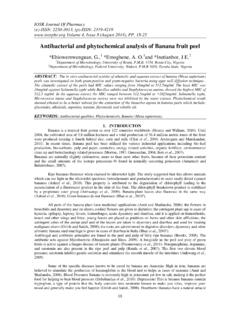Transcription of How to Make a Herbal Apothecary at Home
1 How to Make a Herbal Apothecary at Home 2 Table of Contents Building a Herbal Apothecary .. 5 Let s Get Started .. 6 Optional Equipment .. 7 Storing Your Herbal Medicines .. 8 Common Terms and Their Meanings .. 9 Types of Herbs .. 9 Terms Used to Describe Properties of Herbs and Medicines .. 9 Choosing Herbs ..12 Sourcing Your Medicinal Herbs ..13 My Herbal Choices ..14 Aloe Vera ..14 Angelica archangelica ..14 Bottle Gourd, Lagenaria siceraria ..15 Boneset ..15 Calendula ..16 Chamomile, Matricaria recutita ..17 Cinnamon cassia ..17 Cleavers, Galium aparine ..18 Dandelion, Taraxacum officinale ..19 Elderberry Sambucus nigra ..19 Evening Primrose ..20 Fennel Foeniculum vulgare ..21 Garlic, Allium sativum ..22 Ginger, Zingiber officinale ..23 How to Make a Herbal Apothecary at Home 3 Greater Burdock, Arctium lappa ..23 Goldenseal, Hydrastis canadensis L.
2 25 Marshmallow, Althaea officinalis ..25 Milk Thistle, Silybum marianum ..26 Nettle, Urtica dioica ..27 Peppermint, Mentha piperita ..28 Red Clover, Trifolium pretense ..29 Sheep Sorrel, Rumex acetosella ..30 St. John s Wort ..30 Valerian, Valeriana edulis ..31 White Mustard, Sinapis alba ..32 Wooly Lamb s Ear, Stachys byzantine ..33 Yarrow, Achillea Making Basic Herbal Formulas ..35 Making an Infusion ..35 A Hot Infusion ..35 A Cold Infusion ..36 A Long Infusion ..36 Making a Decoction ..37 Steams ..37 Poultices ..38 Making a Compress ..38 Tinctures ..39 About Solvents for Tinctures ..40 Using Tinctures ..40 Steam Distilled Oils ..40 How to Make a Herbal Apothecary at Home 4 Building a Pressure Cooker Still ..41 Instructions for Steam Distillation of Essential Herb Infused Oils ..42 Heat Method ..42 No Heat Method for Dry Herbs Only.
3 43 Liniments ..43 Salves ..44 Herb Capsules ..45 Keeping Records and Expanding Your Skills ..45 How to Make a Herbal Apothecary at Home 5 c Building a Herbal Apothecary Having your own Herbal Apothecary at home will allow you to treat yourself and your loved ones naturally when the need arrives. It also stands as an excellent backup plan for medicinal use when the drugs you need are no longer available. To use your Apothecary as an effective backup, you need a knowledge of the herbs, information on how to make your medicines and how to use them. I will attempt to show you how to build and use your own home Apothecary here. I recommend that you stock herbs for all possibilities now. If you wait until you have the need, you ll have to wait for your plants to grow or for your herbs to arrive. I am not a doctor, and you should do your own study of any herb you intend to use.
4 I will provide the basics here, but you are responsible for doing your own research as well. The herbs that I recommend are considered safe, but there are sometimes people with allergies or reactions. Do your research first. How to Make a Herbal Apothecary at Home 6 Let s Get Started You will need some basic equipment in addition to the herbs. Many of these items you may already have around the house. I suggest that you keep a supply separate for use in making and storing medicines. Here is a list of the basics you will need: 1. Mason Jars in all sizes, with lids. Many recipes use a mason jar to contain Herbal mixtures while brewing and an airtight jar is a good way to store dried herbs for future use. You can also use other types of jars, but canning jars can withstand the hot and cold temperatures you will be using.
5 2. Dark colored bottles with tight lids and eye droppers. These jars come in sizes from 5 ml to 1 liter or more. I keep a supply of various sizes available. 3. A scale capable of weighing small quantities of herbs. You should be able to weigh in grams or ounces. An inexpensive digital scale will do the job. Look for a scale that can weigh as little as tenths or even hundredths of a gram or as much as a kilogram or more. 4. A digital thermometer. You don t need the fancy version, just a basic candy thermometer will do fine. If you have the budget, an infrared version is convenient. You need to be able to test temperatures when cooking, distilling, or extracting. 5. Bowls, measuring cups, measuring spoons, and graduated cylinders made from glass or polypropylene. 6. Funnels in a variety of sizes for transferring herbs into jars and bottles.
6 7. A dehydrator, if you plan to grow or scavenge for your herbs. Herbs can be purchased already dried but drying your own allows you to control the quality and freshness. If you don t have a dehydrator, you can use an oven or dry your herbs in the sun, but a dehydrator allows you to control the temperatures for best results. How to Make a Herbal Apothecary at Home 7 8. A coffee or herb grinder. I prefer an electric coffee grinder to make this job quick and easy. You can also use a blender, mortar and pestle, or manual grinder. 9. A mortar and pestle are handy for grinding and powdering small amounts of herbs or use a cylindrical model for larger quantities. Using a mortar and pestle is a lot of hard work and I prefer the coffee grinder in most instances, but for small quantities and rare herbs, sometimes you need the mortar and pestle.
7 10. Strainers and filter paper. I start the filtering process with a fine gold mesh coffee strainer and then pour it through an unbleached paper filter. (Keep a separate filter that is used only for herbs.) 11. Solvents: distilled water, alcohol (80 to 100 proof or higher), glycerin, oils, vinegar and witch hazel extract. 12. Beeswax for making salves. 13. Labels for all jars, bottles, and tins. Use ink or permanent marker. 14. A good book or binder of information on using herbs for specific conditions. Optional Equipment 15. Syringes (no needles required). I keep a supply of syringes in different sizes for measuring accurate doses. I mostly use a 5 ml syringe for measuring the doses of extracts and tinctures. 16. Capsules and a capsule loading machine. I use these for taking dried herbs. They are especially beneficial with herbs that have bitter or otherwise unpleasant flavors.
8 The loading machine is not necessary, but it makes it much easier to make 25 to 100 capsules, or more, quickly. The 00 size is usually big enough to hold the herbs, but small enough to swallow. 17. A small perfume still for oil distillation. 18. A double boiler for making infusions. 19. A mini-crockpot for making herb infused oils. It can also replace the double boiler in some cases. How to Make a Herbal Apothecary at Home 8 Storing Your Herbal Medicines You ve probably seen the pictures of herbs hanging from the rafters to dry, but this is not an ideal way to keep your herbs potency. Herbs are degraded by light, moisture, and heat, so your kitchen rafters are probably the worst possible spot. However, it does make a nice picture. Store your herbs and Herbal medicines in a cool, dry place. Not the refrigerator.
9 A basement shelf or a dark pantry in an airconditioned room would be ideal. If you live in a humid environment, throw a desiccant packet or two in your pantry. Keep them in dark bottles that block light from entering the bottle. When making some preparations, I use mason jars. I try to keep them in a dark cupboard. If you don t have a dark cupboard, wrap the jar in a paper bag or a square of cloth. Did you ever wonder why you see pictures of jars wrapped in gingham cloth? Now you know. How to Make a Herbal Apothecary at Home 9 Common Terms and Their Meanings Types of Herbs Warming herbs are herbs the speed up the metabolism, stimulate energy production, increase blood flow and warm the body. Cooling herbs slow down the metabolism, decrease energy production and cool inflammation and irritation.
10 Neutral Herbs neither warm or cool the body but have an effect on the circulation or cellular metabolism. Moistening herbs increase the moisture retention of tissues, lubricating and softening dry, brittle, or hardened tissue. Drying herbs remove excess moisture from tissue, firming it and relieving swelling and dampness. Balancing herbs are neither moistening or drying, but balance the moisture levels in the tissue. Terms Used to Describe Properties of Herbs and Medicines Alkaloid: one of a large, varied group of alkaline compounds which react with acids to form soluble salts. Many alkaloids, such as caffeine, nicotine, and cocaine, have physiological effects on humans. Alterative: an herb or medicinal that gradually restores health. Analgesic: a pain-relieving medicine. Antibiotic: An agent that kills or inhibits the growth or multiplication of a living organism such as bacteria and other micro-organisms.









